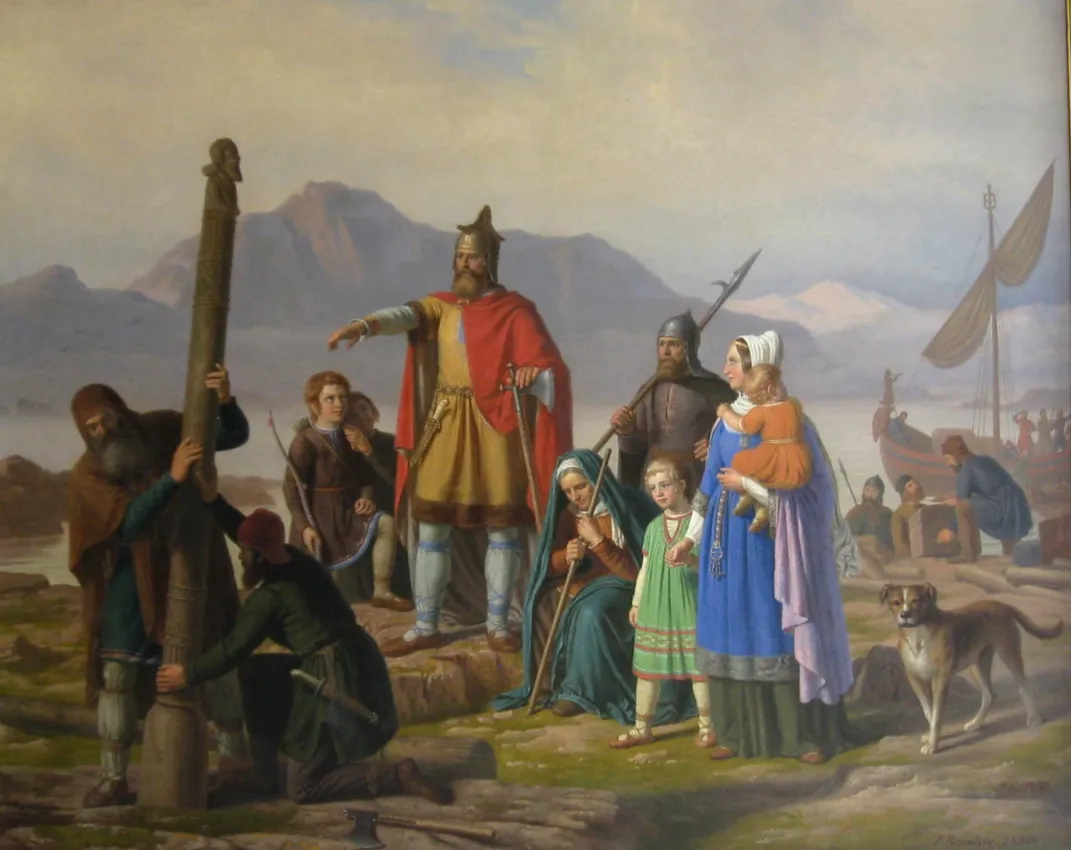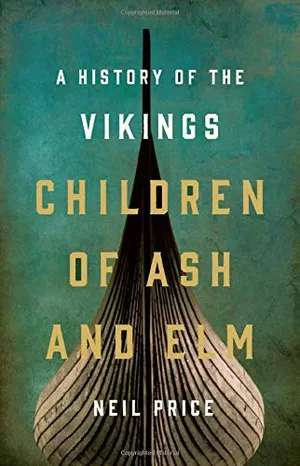The Little-Known Role of Slavery in Viking Society
A new book looks at the legendary Scandinavians through their own eyes
:focal(800x594:801x595)/https://tf-cmsv2-smithsonianmag-media.s3.amazonaws.com/filer/bd/72/bd729b0a-3ccc-44bd-a239-fa37ce98c934/viking.jpg)
One of the most enduring components of the Viking image is the notion of freedom—the adventure of a far horizon and all that went with it. But for many, this was an unattainable hope. Any true reading of life in the Viking Age first has to come to terms with an aspect of everyday experience that probably represented the most elemental division in societies at the time: the difference between those who were free and those who were not. Beneath the social network, any other distinction of status, class, opportunity and wealth pales beside the most basic fact of liberty and the consequent potential for choice.
The institution of slavery had long antecedents in Scandinavia, probably going back thousands of years before the time of the Vikings. By the eighth century A.D., a considerable population of unfree people lived in the North, their condition largely a hereditary one built up over generations. In the Viking Age, this picture changed dramatically because, for the first time, Scandinavians began to make the active acquisition of human chattel a key part of their economy. This was one of the primary objectives of Viking raids and military campaigns—and the result was a massive increase in the numbers of enslaved people in Scandinavia.
Let it therefore be clearly stated: The Vikings were slavers, and the kidnapping, sale and forced exploitation of human beings was always a central pillar of their culture.
Children of Ash and Elm: A History of the Vikings
The definitive history of the Vikings—from arts and culture to politics and cosmology—by a distinguished archaeologist with decades of expertise
One reason why this reality has made so little public impact is that the conventional vocabularies of enslavement—as employed by academics and others working on, for example, the transatlantic trade of more recent centuries—have rarely been applied to the Viking Age. In particular, there is ambiguity in the terminology because a very different word has always been used in place of “slave”: the Old Norse thræll—giving us the modern English “thrall,” which we now use as in being enthralled by a person, a work of art or an idea.
A judicious combination of archaeological and textual sources can produce a relatively comprehensive picture of Viking slaveholding. One intermediate state of servitude, for instance, was voluntary up to a point, albeit entered into under considerable economic compulsion, such as a means of clearing debts. Certain crimes were also punishable by serving as a thrall for a fixed period of time.
The Norse system of thralldom was not always complete chattel slavery, but most of the enslaved had little agency. As two prominent Viking scholars observed 50 years ago, “The slave could own nothing, inherit nothing, leave nothing.” They were not paid, of course, but in some circumstances, they were allowed to retain a small portion of the proceeds they obtained at market when selling goods for their owners. As a result, it was technically possible, though rare, for a thrall to purchase his or her freedom. They could also be manumitted, or released from slavery, at any time. Based on these parameters, some scholars have argued that the number of actual enslaved people in Viking Age society was relatively low. But as researchers conduct additional analysis of detailed European records of Viking slave-taking raids, the scale of this trade has been revised sharply upward.

Some thralls were born into slavery because both of their parents were enslaved, or a freeborn man who had impregnated their enslaved mother declined to acknowledge the child. Others were taken captive, either in raids undertaken specifically for that purpose or as prisoners of war. Though an enslaved individual might pass through many hands in a journey lasting months or years, the experience almost always began with a violent kidnapping. Behind every Viking raid, usually visualized today as an arrow or name on a map, was the appalling trauma visited upon all people at the moment of enslavement, the disbelieving experience of passing from person to property in seconds.
Not all enslaved people—indeed, perhaps only a small minority—were retained personally by their captors and put to work. The majority entered the wider network of trafficking and were transported to markets and points of sale in settlements across the Viking world and beyond, even reaching the emporia of western Europe. Over time, slaving become arguably the main element of the trade that developed during the Viking Age along the eastern rivers of European Russia and what is now Ukraine. No solid infrastructure of purpose-built slave markets, with auction blocks and the like, existed. Instead, transactions were small-scale but frequent, with one or two individuals sold at a time in any circumstances that seemed viable.
The List of Ríg—one of the Old Norse so-called Eddic poems—is a curious work that purports to describe the divine origin of human social classes. In the story, the god Heimdall, using the name Ríg, visits three households in turn. One is humble and impoverished, while the second is modest but well-kept and the third wealthy and proud. Ríg spends three nights at each house, sleeping between the couples living there, and in due course, a series of children are born—the progenitors of the thralls, the farmers and the elites, respectively. The poem includes a list of names appropriate to these characters’ stations in life: The “first couple” of the enslaved class are called Thræll and Thír, the latter name effectively meaning “thrall-woman.” Their sons’ names translate as Noisy, Byreboy, Stout, Sticky, Bedmate, Badbreath, Stumpy, Fatty, Sluggish, Grizzled, Stooper and Longlegs. The daughters are dubbed Stumpina (a feminine form of the male equivalent, with the sense of a demeaning joke), Dumpy, Bulgingcalves, Bellowsnose, Shouty, Bondwoman, Greatgossip, Raggedyhips and Craneshanks. All clearly pejoratives, several of the monikers imply ill health and a lack of hygiene, and one clearly refers to sexual servitude. None of them acknowledge individual identity or personality.
/https://tf-cmsv2-smithsonianmag-media.s3.amazonaws.com/filer/19/e9/19e9dc8f-77cf-4465-887c-8862613da287/shackles-from-the-viking-age-town-of-birka-sweden-above-left-neu-niekoehr-germany.png)
The poem also outlines the tasks performed by the enslaved: Thræll carries heavy bundles of kindling and plaits materials for basket making, while his family “fixed fences, dunged fields, worked at the pigs, watched over the goats, dug the peat.” Their bodies are marked by manual labor, with wrinkled skin burnt by the sun, scabbed nails, gnarled knuckles and dull eyes. Their bare feet are covered with soil.
A tiny handful of texts preserve the actual voices of the enslaved. One is an 11th-century, highly decorated runestone from Hovgården, the royal estate on Adelsö island in Lake Mälaren, Sweden. The inscription honors the king’s estate manager and is a rare example of people erecting a stone to themselves while alive:
Read these runes! They were properly ordered cut by Tolir, the bryti in Roden, appointed by the king. Tolir and Gylla had them cut, husband and wife to their own memory ... Hákon did the carving.
The key fact here is that a bryti was a special class of thrall, someone entrusted with much responsibility but lacking liberty nonetheless. In other cultures, parallel accounts of enslaved individuals rising to positions of sometimes considerable power blur the lines of what their status actually meant. On Adelsö, Tolir was clearly able to marry (whether this had legal standing is another matter) and afford a magnificent statement of his position as the royal servant.
Another 11th-century stone from Hørning in Denmark tells a simpler, but perhaps more poignant, tale:
Tóki the blacksmith raised this stone to the memory of Thorgisl, son of Gudmund, who gave him gold and freed him.
/https://tf-cmsv2-smithsonianmag-media.s3.amazonaws.com/filer/72/c9/72c94d1a-981f-4d44-b4e9-081f4f99ce55/gettyimages-1036124986.jpg)
A freed thrall existed in the ambiguous space between enslavement and complete liberty. All freed(wo)men remained obligated to their former owners and were expected to support them, and they were never regarded as fully the equal of freeborn folk. Former thralls also had lower rights to compensation in legal codes. The stone raised by Tóki indicates his profession—a handy, useful occupation—but whether this was something new or a legacy of his former tasks as a thrall is unclear. In time, the children and grandchildren of freed thralls would gain the full rights of the freeborn.
Material reflections of Viking-Age slavery are meager but significant. At the most basic level, iron shackles have been found in the urban centers of Birka and Hedeby, as well as a handful of other sites connected with commerce. Some of them arguably could have been used to restrain animals but were more likely designed to be placed around a human neck, wrist or ankle.
Most of the archaeological material is harder to read, in that it only indirectly reflects the presence of the enslaved. They would have needed housing and feeding, and their work must have been not only integrated into the economy but perhaps also a main driver of it. In the early Viking Age, for example, who serviced the rapid expansion of the labor-intensive tar production industry, along with the parallel rise in the exploitation of the outlands? Later in the period, further reorganization of the economy, in connection with an escalating need for sailcloth (and therefore wool and sheep), had obvious implications for the consequent rise in labor requirements. Developments in the built environments of the estates, an increase in smaller structures (perhaps thralls’ quarters?), and additions to the main halls and ancillary buildings also occurred. As raiding for enslaved people escalated, these individuals’ work became essential for building, equipping and maintaining the fleets used in such assaults, and so on in a self-reinforcing system.
For the enslaved, the mid-8th to mid-11th centuries A.D. were an utterly different experience from that of the free people around them. The Viking Age was very much a time of borders—between cultures and ways of life, between different views of reality, and between individuals, including at the level of liberty itself.
Adapted from Children of Ash and Elm: A History of the Vikings by Neil Price. Copyright © 2020 by Neil Price. Available from Basic Books.
A Note to our Readers
Smithsonian magazine participates in affiliate link advertising programs. If you purchase an item through these links, we receive a commission.
/https://tf-cmsv2-smithsonianmag-media.s3.amazonaws.com/accounts/headshot/Price_Neil_Linda_Qvistrom.JPG)

/https://tf-cmsv2-smithsonianmag-media.s3.amazonaws.com/accounts/headshot/Price_Neil_Linda_Qvistrom.JPG)